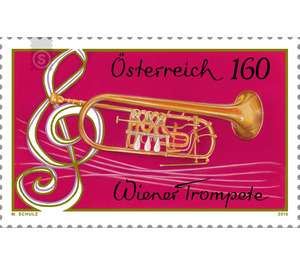Musical instruments - Austria / II. Republic of Austria 2016 - 160 Euro Cent
Theme: Art & Culture
| Country | Austria / II. Republic of Austria |
| Issue Date | 2016 |
| Face Value | 160.00 |
| Edition Issued | 180,000 |
| Printing Type | offset |
| Stamp Type | Commemorative |
| Item Type | Stamp |
| Chronological Issue Number | 2584 |
| Chronological Chapter | OOS-OE2 |
| SID | 785237 |
| In 65 Wishlists | |
The present stamp shows a trumpet, as it is built in Austria and Germany; it differs from the trumpets used for example in the USA through the valves. The former has rotary valves, not Périnet valves, as pump valves are also called. In addition, the valve stems of the rotary valves are mounted at a different location than those of the Périnet valves, namely at a different distance from the mouthpiece. This positioning, as well as the valve type itself, ensures that the timbre of the Austrian and German trumpets is different from that of the trumpets used in the rest of the world. But what is the special Wienerische, where trumpets with rotary valves are also produced in Germany? The difference is less in the instrument than in the sound. The "Institut für Wiener Klangstil" speaks of a specific kind of interpretation "that clearly differs from international practices in terms of stylistic execution and tonal preferences". This is probably due to the special sense of tradition of the Austrian instrumentalists: The Viennese sound style came about because the local musicians were not willing to participate in all 19th century innovations in instrumental engineering, which should bring a larger sound volume and easier playability. So it's not just a matter of whether a trumpet in Austria can produce a lower tone or a lower tone, whether the trumpet here or elsewhere in the world sounds brighter or darker, and whether softer or clearer, more abrupt tone combinations are possible - all this makes a difference Trumpets in German-speaking countries generally of those of other origins. In addition, it is mainly about the Viennese play tradition and about instrument makers like Lechner, Schagerl and Co, who are preferred by musicians here.


